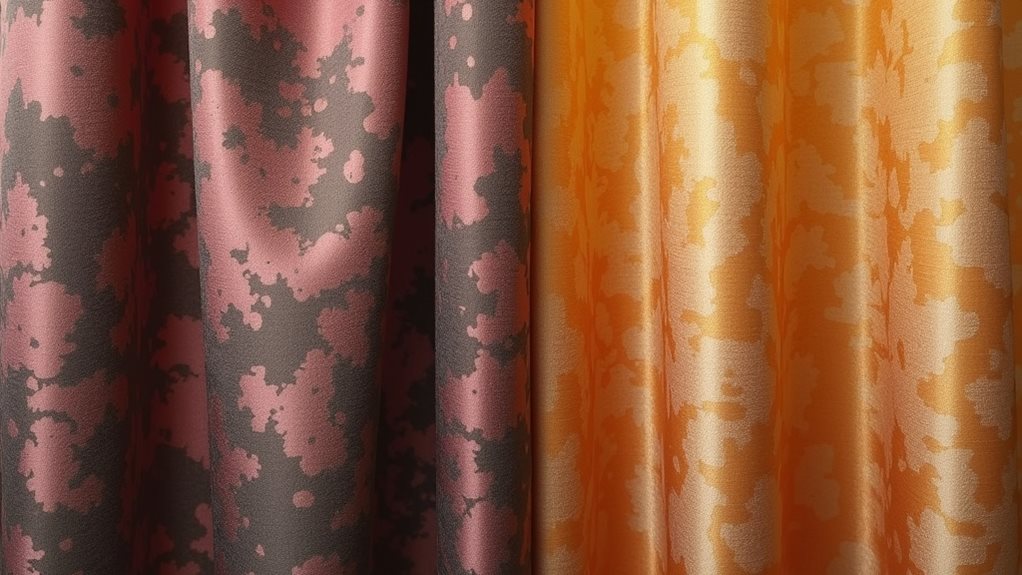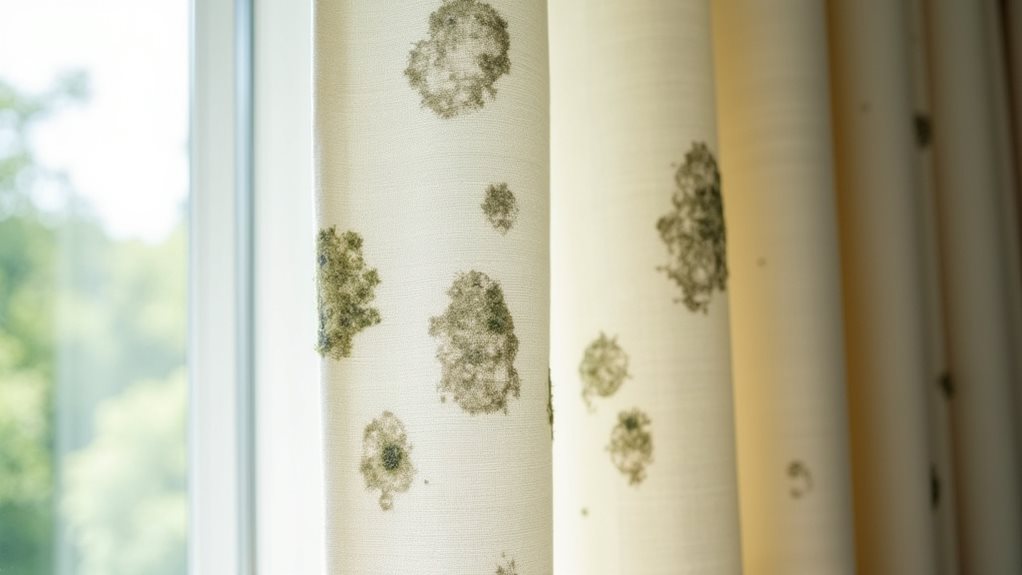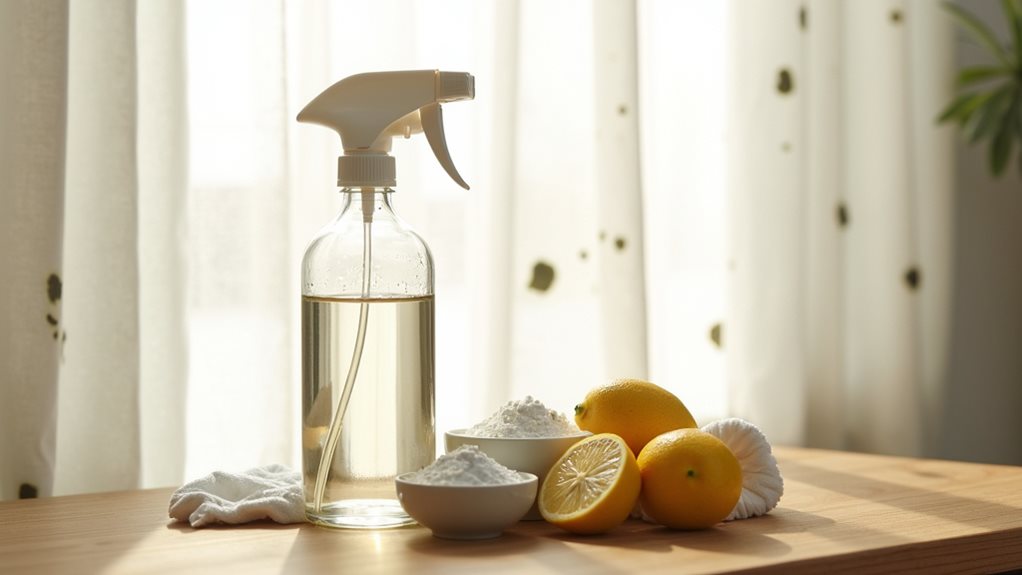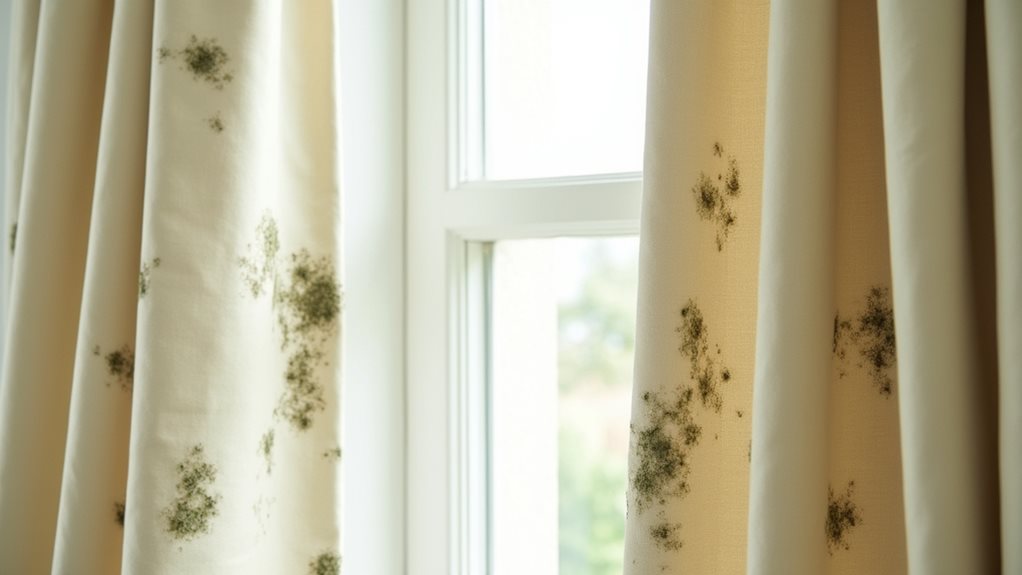Yes, dry cleaning can effectively remove mould from curtains using powerful solvents like perchloroethylene that dissolve oils and target spores, while the high heat (60-63°C) kills most mould varieties. Cotton and linen respond particularly well, though delicate fabrics need extra care, and severely infested curtains may require multiple treatments or pre-treatment with specialized removers. However, black mould and deeply embedded spores might resist even professional cleaning, so exploring additional strategies becomes crucial.
Understanding How Dry Cleaning Works Against Mould
While many people assume dry cleaning is just a fancy way to wash delicate fabrics, it’s actually a surprisingly effective weapon against mould that’s been lurking in your curtains like an unwelcome house guest 🏠.
The magic happens when professional cleaners use powerful solvents like perchloroethylene, which dissolve oils and greases while simultaneously attacking mould spores that regular washing might miss.
Professional dry cleaning solvents like perchloroethylene work their magic by dissolving stubborn oils while simultaneously eliminating mould spores that ordinary washing leaves behind.
What really gets me excited about this cleaning process is how the heat reaches 60-63°C, creating an environment where most mould varieties simply can’t survive.
However, I’ve learned that success depends heavily on your fabric type and how severe the infestation has become.
For stubborn mildew stains, pre-treatment becomes crucial to remove mould completely, though professional cleaners can’t always guarantee total elimination.
Keep in mind that curtains with extensive contamination may require professional mold remediation services before the dry cleaning process can be fully effective.
Effectiveness of Professional Dry Cleaning on Different Curtain Fabrics

When I first started researching which curtain fabrics respond best to professional dry cleaning for mould removal, I discovered that cotton and linen curtains are absolute champions in this battle, since the powerful solvents penetrate their natural fibers beautifully and eliminate both the mould spores and those stubborn oils that feed them 💪.
However, you’ll need to approach delicate fabrics like sequins or rayon with extreme caution, as they can’t handle the heat and chemicals involved in curtain cleaning processes.
I’ve learned that professional dry cleaners often use pre-treatment with specialized stain remover products to tackle severe mould growth before the main cleaning cycle, which can kill mould more effectively depending on your specific fabric type.
Keep in mind that while perchloroethylene solvents used in dry cleaning can kill many types of mould, deeply embedded spores in porous curtain materials may require multiple treatment cycles to achieve complete removal.
When Dry Cleaning May Not Be Sufficient for Mould Removal

Although dry cleaning works wonders for many mould situations, I’ve unfortunately discovered through some expensive mistakes that it’s not always the silver bullet we hope it’ll be, especially when you’re dealing with those nightmare scenarios where mould has practically moved in and made itself at home in your curtains 😅.
When black mould has deeply penetrated your fabric composition, dry cleaning alone won’t rid of mould completely, leaving you frustrated and still dealing with lingering spores.
Professional cleaners often recommend pre-treatment before attempting standard cleaning methods, but severe mould and mildew infestations may require alternative treatments entirely.
The effectiveness really depends on how long that unwelcome guest has been growing, making early intervention absolutely essential for successful removal.
While dry cleaning uses chemical solvents like perchloroethylene that can kill some mold spores, it cannot guarantee complete mold elimination from heavily infested curtains.
Alternative Methods for Treating Mouldy Curtains at Home

Fortunately, you don’t have to throw in the towel just because professional dry cleaning hasn’t worked its magic, and I’ve learned through plenty of trial and error that your own home can become a surprisingly effective mould-fighting battlefield with the right arsenal of everyday products.
White vinegar becomes your best friend here – just spray it on affected areas after testing a hidden spot first, because nobody wants surprise bleaching disasters (trust me on this one 😅).
Regular washing powder applied directly overnight works wonders before a machine wash, while Vanish soaking solutions tackle stubborn spots brilliantly.
Keep in mind that severely moldy items may be beyond salvaging regardless of the cleaning method you choose, so assess the extent of contamination before investing too much time and effort.
Preventing Future Mould Growth on Your Curtains

Since discovering that prevention truly trumps any cure when it comes to mould battles, I’ve transformed my approach from reactive panic-cleaning to proactive curtain care, and honestly, it’s saved me countless hours of scrubbing and stress-induced headaches.
Getting rid of mould once it’s established often requires professional dry cleaners, but creating an environment where it can’t thrive saves you that expense entirely.
Prevention costs pennies compared to professional mould removal – stop the problem before it starts rather than paying to fix it later.
Here’s my three-step prevention strategy that’s worked wonders:
- Control humidity levels below 50% using a dehumidifier – this eliminates mould’s favorite breeding ground
- Keep opening windows regularly for fresh air circulation, especially after showers or cooking
- Start regularly vacuuming curtains monthly and wash them with anti-mould solutions every few months
This proactive approach beats scrambling for emergency dry cleaning appointments! 🙌
If you do need professional dry cleaning, choose facilities that use safer alternatives like wet cleaning or liquid CO2 instead of traditional solvents to minimize chemical exposure in your home.




